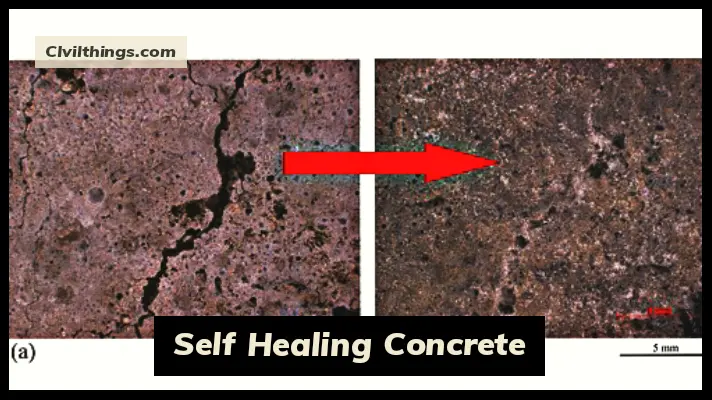
Table of Contents
Introduction
In the dynamic realm of construction materials, self-healing concrete emerges as a groundbreaking innovation, promising to extend the lifespan of structures and minimize maintenance costs. This blog post delves into the various mechanisms and examples of self-healing concrete, exploring its potential applications and real-world implementations.
1. Understanding Self Healing Concrete
Self-healing concrete is a transformative material designed to autonomously repair cracks, addressing one of the primary challenges in concrete durability. This section provides an overview of the key mechanisms behind self-healing concrete and its advantages.
2. Mechanisms of Self Healing
2.1 Bacterial Healing
Example: Bacillus bacteria activation and calcium carbonate production.
2.2 Chemical Healing
Example: Reaction of calcium oxide or calcium silicate with concrete by-products.
2.3 Capsule-Based Healing
Example: Rupture of microcapsules, release of healing agents, and crack sealing.
2.4 Vascular Network Healing
Example: Flow of healing agents through embedded channels to repair cracks.
3. Innovative Applications
3.1 Carbon Nanotubes for Electrical Conductivity
Example: Electrical current induction for crack repair.
3.2 Biomimicry-Inspired Healing
Example: Use of shape-memory polymers for crack closure.
3.3 Bio-Based Healing Agents
Example: Integration of vegetable oils or extracts for resilient self-repair.
4. Real-World Implementation
4.1 Bridge Construction
Example: Increasing bridge lifespan in harsh environmental conditions.
4.2 Tunnel Linings
Example: Durability enhancement in tunnels facing water ingress and chemical exposure.
5. Spotlight on Research
5.1 Delft University of Technology
Example: Exploration of bio-based healing agents encapsulated in microcapsules for successful crack healing.
6. Technical Insights
To delve deeper into the technical aspects, let’s explore a table that highlights key information regarding self-healing concrete.
| Ingredients | Percentage | MPa (Compressive Strength) | Curing Time |
|---|---|---|---|
| Microcapsules with Bacteria | 1-2% | Varies | Activated by Moisture |
| Calcium Oxide or Silicate | 3-5% | Varies | Reaction time depends on crack severity |
| Carbon Nanotubes | 0.1-0.5% | Enhanced Electrical Conductivity | Variable |
| Bio-Based Healing Agents | Varies | Enhanced Durability | Varies based on material |
Conclusion
As we look ahead, self healing concrete stands poised to redefine the landscape of construction materials. From its diverse mechanisms to real-world applications, this innovative material holds the potential to revolutionize the industry by enhancing the durability, sustainability, and longevity of concrete structures. The ongoing research and development in self-healing concrete promise a future where structures can autonomously repair and thrive in the face of environmental challenges.
FAQ ON SELF HEALING CONCRETE
What is self-healing concrete?
Self-healing concrete is an innovative construction material designed to autonomously repair cracks that may develop over time. It employs various mechanisms, such as bacteria, chemicals, or capsules, to enhance the durability and longevity of concrete structures.
How does self-healing concrete work’s
Answer: Self-healing concrete works through mechanisms like bacterial healing, chemical reactions, capsule-based systems, and vascular networks. When cracks form, these mechanisms are triggered, releasing healing agents that repair and seal the damaged areas.
What are the advantages of using self-healing concrete?
Answer: The advantages of self-healing concrete include an extended lifespan for structures, reduced maintenance costs, and enhanced overall durability. It provides a proactive solution to address concrete deterioration caused by environmental factors and structural loading.
How effective is self-healing concrete in practical scenarios?
The effectiveness of self-healing concrete depends on factors like the type of mechanism used, the severity of cracks, and the specific application. Ongoing research aims to optimize these mechanisms and evaluate their long-term performance in real-world settings.
What is the future outlook for self-healing concrete?
The future of self-healing concrete looks promising, with ongoing research aimed at improving its effectiveness, reducing costs, and expanding its practical applications. As the technology matures, it has the potential to become a standard in the construction industry, contributing to more resilient and sustainable infrastructure.

Hi! I’m Sandip, a civil engineer who loves sharing about Civil Engineering & new ideas and tips. My blog helps you learn about engineering in a fun and easy way!

1 thought on “Why Self Healing Concrete Used in Construction”